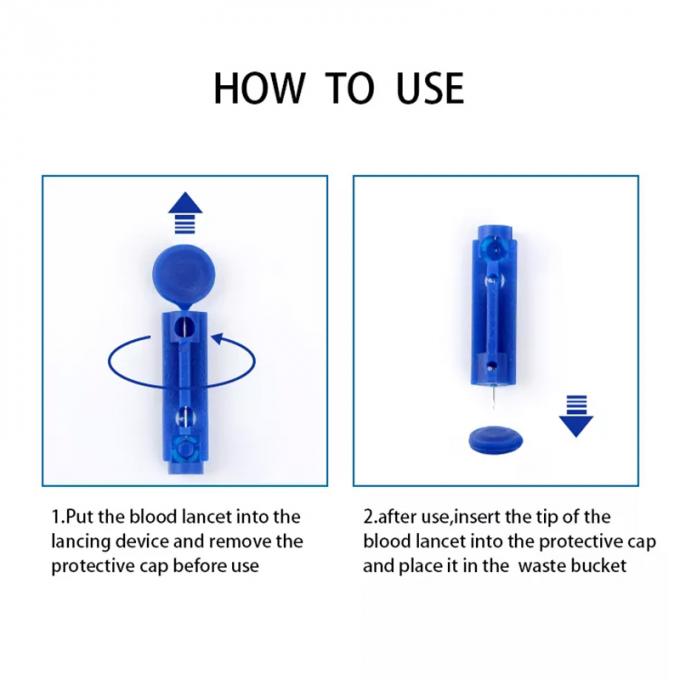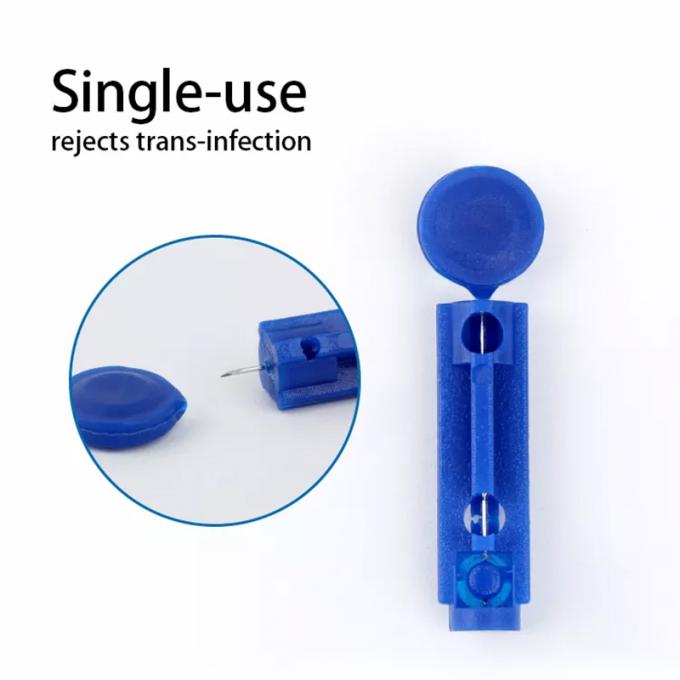Henan Aile Industry CO.,LTD. |
|
Verified Suppliers
|
|
Disposable Twist Sterile Safety Blood Lancets Taking Glucose Test Sugar Test Needle
Instruction for Use: lancet
SAFE:
1.All needle are EO-sterile and protect with a sterility tab.
2.Fully enclosed needle housing ensuring that needles is hidden
before and after use to prevent sharps injuries.
3.Can be used in hospital or at home and It's disposable.
Safety blood lancets are medical devices used for obtaining blood samples from patients. They are designed with safety features to reduce the risk of accidental needlestick injuries and ensure safe disposal.
Retractable Needles: Safety lancets typically have retractable needles that automatically retract or withdraw into the device after use. This feature eliminates the need for manual retraction and reduces the chance of accidental needlestick injuries.
Protective Caps: Lancets may come with protective caps that cover the needle before and after use. The cap helps prevent accidental contact with the needle, reducing the risk of injury.
Activation Mechanisms: Safety lancets often incorporate various activation mechanisms to initiate the puncture process. These mechanisms can include push-button activation, twist-and-release mechanisms, or pressure triggers. They require intentional action to activate the lancet and minimize the risk of accidental needlesticks.
Single-Use Only: Most safety blood lancets are designed for single-use only, meaning they should not be reused. This feature promotes hygiene and reduces the risk of cross-contamination.
Disposal Containers: Some safety lancets are packaged with disposal containers specifically designed for safe disposal. These containers may have built-in needle removal systems or lockable lids to ensure the safe containment and disposal of used lancets.
It's important to follow proper procedures for using, handling, and disposing of safety blood lancets to ensure maximum safety for both healthcare providers and patients. Always consult the instructions provided by the manufacturer and follow the guidelines established by healthcare regulatory bodies.

Usage of Blood Lancets:
Gather supplies: Ensure you have a blood lancet device, lancets, alcohol swabs, and a suitable collection device, such as a test strip or blood collection tube.
Hand hygiene: Wash your hands thoroughly with soap and water or use an alcohol-based hand sanitizer to maintain proper hand hygiene.
Select the puncture site: Depending on the purpose of the blood sample, select an appropriate puncture site. Common sites include the fingertip (most commonly used for blood glucose monitoring), alternate sites (e.g., forearm or palm), or the heel for infants.
Prepare the puncture site: Cleanse the selected site with an alcohol swab and allow it to dry completely. This helps reduce the risk of infection.
Load the lancet: Follow the instructions provided with your specific blood lancet device to load a fresh lancet into the device. Twist off the protective cap of the lancet and insert it securely into the lancet device.
Adjust the depth setting: Some blood lancet devices allow you to adjust the depth of the puncture to suit your individual needs. Set the depth according to the instructions or as recommended by your healthcare provider.
Position the device: Hold the blood lancet device firmly against the selected puncture site, aligning the lancet with the desired location for the blood sample.
Activate the lancet: Press the button or trigger on the blood lancet device to activate the lancet. This action causes the lancet to quickly puncture the skin and withdraw.
Obtain the blood sample: Allow a droplet of blood to form at the puncture site. Depending on the required amount, you can either touch the collection device (such as a test strip) to the blood droplet or gently squeeze the surrounding area to encourage blood flow.
Dispose of the lancet safely: Immediately after use, carefully remove the lancet from the device, following the manufacturer's instructions. Dispose of the used lancet in a sharps container or a puncture-resistant container as per local regulations.
Clean and care for the puncture site: Apply gentle pressure to the puncture site with a clean gauze pad or tissue to stop any bleeding. Once bleeding has stopped, clean the site again with an alcohol swab and apply a bandage if needed.
SIMPLE:
1.Easy to handle,intuitive activation in 2 steps only with no
pre-loading,for both push button and contact activation.
2.Wide and long safety cap for easy removal-simply twist and pull
to remove the needle cover.
3.Precise designs for convenient finger positioning and ideal blood
sample collection.
Specification
| Product structure | Blood lancet |
| Material | Material |
| Printing | According to the client’s logo printing |
| Style | Stainless steel type |
| Application | Medical, Clinical offices ,Pharmacy,Laboratory,Hospital etc. |


How does lancet draw blood?
A blood lancet, sometimes called a lance, is similar to a scalpel style lancet, but with a double-edged blade and a pointed end. It can even be a specialized type of sharp needle. Lancets are used to make punctures, such as a fingerstick, to obtain small blood specimens. Blood lancets are generally disposable.
What is the difference between a lancet and a needle?
Lancets are small needles that are used to prick the skin when testing to obtain a blood sample. Many lancets can be used with a lancing device that helps to make it more effective and less painful, however they can be used without one by just sticking the skin directly with the needle.
What size lancet hurts the least?
The finer and narrower the needle, the less painful it is in use. Oddly, higher gauge numbers indicate finer and narrower needles, while lower gauge numbers indicate heavier, thicker needles. So a 33G lancet is thinner and more desirable than a 30G lancet. It is best to use a new, sterile lancet with each jab
Can we provide samples?
Yes, we offer samples, but some samples need to be paid, sample charges would be returned after you place orders.